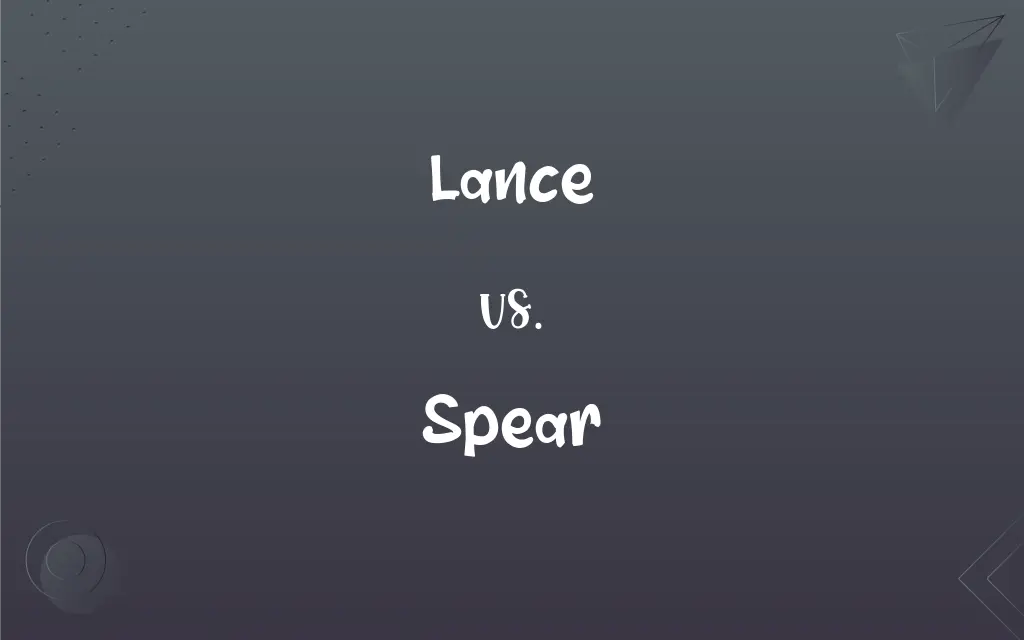Lance vs. Spear: What's the Difference?
By Harlon Moss & Janet White || Updated on March 4, 2024
A lance is a long, thrusting weapon traditionally used by cavalry in charging attacks, often designed for single-use combat, while a spear is a versatile pole weapon used for both throwing and thrusting, by infantry and hunters across various cultures.

Key Differences
Lances and spears are both ancient weapons that have played significant roles in warfare and hunting throughout human history. The main distinction between the two lies in their design, intended use, and historical context.
Lances are characterized by their long shafts and pointed tips, specifically designed for mounted warfare. They are typically wielded with both hands and used in a couched position under the arm to maximize the force of the cavalry charge, aiming to break enemy lines or engage in jousting tournaments. Spears, on the other hand, are more versatile weapons that can be used for both thrusting and throwing. They have been utilized by foot soldiers and hunters alike, featuring a shaft with a pointed head, which can be made of various materials like flint, metal, or wood
The differences between lances and spears highlight the evolution of warfare techniques and the specific needs of combatants in different historical and cultural contexts.
Comparison Chart
Primary Use
Mounted warfare, charging attacks
Versatile use in thrusting, throwing, and close combat
Design
Long shaft, often used in a couched position
Shorter than a lance, designed for hand-held use
ADVERTISEMENT
Combat Style
Single-use in charges, not for prolonged melee
Reusable in multiple combat scenarios
Historical Context
Favored by medieval cavalry
Used by various cultures across history for warfare and hunting
Construction
Often designed to break upon impact
Durable, meant for repeated use
Lance and Spear Definitions
Lance
Characterized by its use in mounted combat.
The cavalryman readied his lance for the charge.
Spear
Featured in both warfare and ceremonial contexts.
Spears were not only weapons but also symbols of authority in some cultures.
ADVERTISEMENT
Lance
Often disposable after a single use.
The lance shattered upon impact as intended.
Spear
A versatile weapon for throwing or thrusting.
The hunter threw his spear with precision at the game.
Lance
A weapon designed for medieval cavalry charges.
Knights used lances to unhorse their opponents in tournaments.
Spear
Used by infantry across various cultures.
Ancient Greek hoplites wielded spears in phalanx formations.
Lance
Used in jousting tournaments.
Jousting lances were blunted to reduce fatalities.
Spear
Designed for hand-held combat.
The warrior engaged his enemy with a swift spear thrust.
Lance
Symbol of knightly warfare.
The lance became a symbol of the medieval knight's prowess.
Spear
Essential for early human hunting techniques.
Early humans used spears to hunt large animals.
Lance
A thrusting weapon with a long wooden shaft and a sharp metal head.
Spear
A weapon consisting of a long shaft with a sharply pointed end.
Lance
A similar implement for spearing fish.
Spear
A shaft with a sharp point and barbs for spearing fish.
Lance
A cavalry lancer.
Spear
A soldier armed with a spear.
Lance
(Medicine) See lancet.
Spear
A slender stalk, as of asparagus.
Lance
To pierce with a lance.
Spear
To pierce with a spear or other sharp object.
Lance
(Medicine) To make a surgical incision in; cut into
Lance a boil.
Spear
To catch with a thrust of the arm
Spear a grounder.
Lance
A weapon of war, consisting of a long shaft or handle and a steel blade or head; a spear carried by horsemen.
Spear
(Football) To block (an opponent) by ramming with the helmet, in violation of the rules.
Lance
A wooden spear, sometimes hollow, used in jousting or tilting, designed to shatter on impact with the opposing knight’s armour.
Spear
(Sports) To jab (an opponent) with the blade of a hockey stick, in violation of the rules.
Lance
(fishing) A spear or harpoon used by whalers and fishermen.
Spear
To stab at something with a spear or other sharp object.
Lance
(military) A soldier armed with a lance; a lancer.
Spear
To sprout like a spear.
Lance
(military) An instrument which conveys the charge of a piece of ordnance and forces it home.
Spear
A long stick with a sharp tip used as a weapon for throwing or thrusting, or anything used to make a thrusting motion.
Lance
(metallurgy) A small iron rod which suspends the core of the mold in casting a shell.
Spear
A soldier armed with such a weapon; a spearman.
Lance
(pyrotechnics) One of the small paper cases filled with combustible composition, which mark the outlines of a figure.
Spear
A lance with barbed prongs, used by fishermen to retrieve fish.
Lance
(medicine) A lancet.
Spear
(ice hockey) An illegal maneuver using the end of a hockey stick to strike into another hockey player.
Lance
To pierce with a lance, or with any similar weapon.
Seized the due victim, and with fury lanced Her back. Dryden.
Spear
(wrestling) In professional wrestling, a running tackle in which the wrestler's shoulder is driven into the opponent's midsection.
Lance
To open with a lancet; to pierce.
To lance a vein or an abscess
Spear
A shoot, as of grass; a spire.
Lance
To throw in the manner of a lance; to lanch.
Spear
The feather of a horse.
Lance
A weapon of war, consisting of a long shaft or handle and a steel blade or head; a spear carried by horsemen, and often decorated with a small flag; also, a spear or harpoon used by whalers and fishermen.
A braver soldier never couched lance.
Spear
The rod to which the bucket, or plunger, of a pump is attached; a pump rod.
Lance
A soldier armed with a lance; a lancer.
Spear
A long, thin strip from a vegetable.
Asparagus and broccoli spears
Lance
A small iron rod which suspends the core of the mold in casting a shell.
Spear
(botany) The sprout of a plant, stalk
Lance
An instrument which conveys the charge of a piece of ordnance and forces it home.
Spear
(obsolete) A church spire.
Lance
One of the small paper cases filled with combustible composition, which mark the outlines of a figure.
Spear
(transitive) To pierce with a spear.
Lance
A lancet.
Spear
To penetrate or strike with, or as if with, any long narrow object; to make a thrusting motion that catches an object on the tip of a long device.
Lance
To pierce with a lance, or with any similar weapon.
Seized the due victim, and with fury lancedHer back.
Spear
(gridiron football) To tackle an opponent by ramming into them with one's helmet.
Lance
To open with a lancet; to pierce; as, to lance a vein or an abscess.
Spear
(intransitive) To shoot into a long stem, as some plants do.
Lance
To throw in the manner of a lance. See Lanch.
Spear
To ignore as a social snub.
Lance
A long pointed rod used as a weapon
Spear
Pertaining to male family members.
The spear side of the family
Lance
An implement with a shaft and barbed point used for catching fish
Spear
A long, pointed weapon, used in war and hunting, by thrusting or throwing; a weapon with a long shaft and a sharp head or blade; a lance.
They shall beat their swords into plowshares, and their spears into pruning hooks.
Lance
A surgical knife with a pointed double-edged blade; used for punctures and small incisions
Spear
Fig.: A spearman.
Lance
Move quickly, as if by cutting one's way;
Planes lanced towards the shore
Spear
A sharp-pointed instrument with barbs, used for stabbing fish and other animals.
Lance
Pierce with a lance, as in a knights' fight
Spear
A shoot, as of grass; a spire.
Lance
Open by piercing with a lancet;
Lance a boil
Spear
The rod to which the bucket, or plunger, of a pump is attached; a pump rod.
Spear
To pierce with a spear; to kill with a spear; as, to spear a fish.
Spear
To shoot into a long stem, as some plants. See Spire.
Spear
A long pointed rod used as a weapon
Spear
An implement with a shaft and barbed point used for catching fish
Spear
Pierce with a spear;
Spear fish
Spear
Thrust up like a spear;
The branch speared up into the air
FAQs
Why were lances not used for throwing?
Lances were too long and heavy, designed specifically for the momentum of a mounted charge, making them impractical for throwing.
Can a spear be used effectively by cavalry?
While spears can be used by mounted warriors, they lack the specialized design of lances for charging attacks but offer greater versatility.
How did the use of the lance evolve over time?
The lance evolved from a practical weapon of war to a symbol of chivalry and nobility, especially in the context of jousting tournaments.
What is the significance of the spear in cultural symbolism?
The spear often symbolizes martial prowess, authority, and the hunter's skill across various cultures and mythologies.
What role did lances and spears play in non-European cultures?
In many non-European cultures, spears were primary weapons for hunting and warfare, adapted to local materials and techniques, while lances were less common outside of mounted nomadic tribes and certain Asian cavalry traditions.
What materials were used to make lances and spears?
Both were typically made with wooden shafts, but lance tips were often metal for durability in impact, whereas spearheads could be made from metal, flint, or other hard materials.
Are spears still used today?
While not in conventional warfare, spears are still used in ceremonial roles, traditional hunting practices, and as sporting equipment in track and field events.
Were lances ever used by foot soldiers in historical battles?
Lances were primarily cavalry weapons due to their length and weight, making them impractical for foot soldiers who favored shorter, more versatile spears.
What are the key differences in the balance and weight distribution between a lance and a spear?
Lances are balanced for use at speed, often heavier towards the tip to maximize impact in a charge, while spears are balanced for versatility, allowing for effective throwing and thrusting.
How did the introduction of firearms affect the use of lances and spears?
The advent of firearms gradually diminished the military significance of both lances and spears, though they remained ceremonial and symbolic roles.
How do modern interpretations of these weapons compare to their historical uses?
Modern interpretations often emphasize their historical and ceremonial significance, with adaptations for sport, reenactment, and cultural preservation.
What cultural rituals or ceremonies involve lances and spears today?
Lances and spears feature in cultural rituals symbolizing fertility, martial prowess, and the transition to adulthood, as well as in reenactments and ceremonial military units.
What were the tactical advantages of the spear over the lance in infantry combat?
The spear's versatility for throwing, thrusting, and close combat provided infantry with a multifunctional weapon adaptable to various combat scenarios.
What innovations in materials and construction have affected the development of spears and lances?
Advances in metalworking improved the strength and durability of spearheads and lance tips, while innovations in synthetic materials have made shafts lighter and stronger.
How did the design of the spear adapt to different environments and hunting practices?
Spear designs varied with longer shafts for open environments to keep distance from prey or enemies, and shorter, more robust spears for forested areas to maneuver through vegetation.
How have lances and spears been represented in art and literature?
They are often symbolized as tools of heroism and valor; spears are common in myths as divine or magical weapons, while lances are featured in medieval romances and tales of knights.
How did the tactics of using spears change with the formation of organized armies?
Organized armies developed formations like the phalanx and shield wall, where the collective use of spears provided defensive strength and offensive capability.
How did the role of the spear evolve in naval warfare?
In naval engagements, spears were used by boarding parties or to repel them, taking advantage of their reach and versatility in close quarters.
What training was required to effectively wield a lance in cavalry charges?
Knights and cavalrymen underwent extensive training to master the lance, focusing on balance, aiming, and the ability to absorb the impact of hitting a target at high speed.
Are there any notable historical figures known for their skill with a lance or spear?
Historical figures like Alexander the Great and the knights of the Round Table are celebrated for their mastery of the spear and lance, respectively, in battle and tournaments.
About Author
Written by
Harlon MossHarlon is a seasoned quality moderator and accomplished content writer for Difference Wiki. An alumnus of the prestigious University of California, he earned his degree in Computer Science. Leveraging his academic background, Harlon brings a meticulous and informed perspective to his work, ensuring content accuracy and excellence.
Co-written by
Janet WhiteJanet White has been an esteemed writer and blogger for Difference Wiki. Holding a Master's degree in Science and Medical Journalism from the prestigious Boston University, she has consistently demonstrated her expertise and passion for her field. When she's not immersed in her work, Janet relishes her time exercising, delving into a good book, and cherishing moments with friends and family.































































